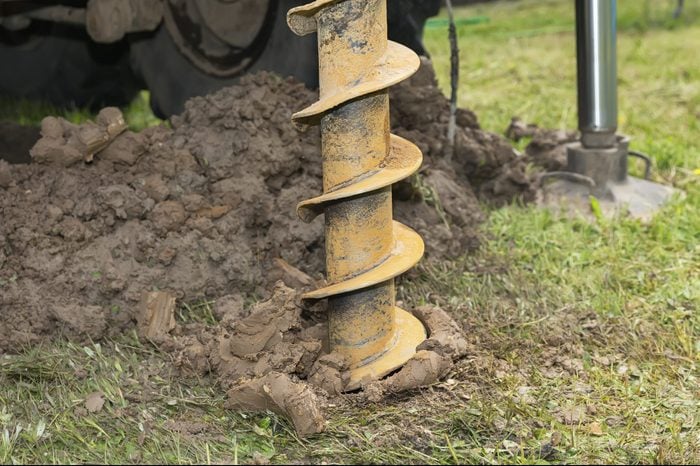What To Know About Digging a Well

Wells are usually dug by pros using heavy equipment, and they can be expensive. If you have a well in your future, here's some info you can use.
If you’re thinking about DIYing a new well for your household, you probably shouldn’t. Most wells, like the one on our property, are between 50 and several hundred feet deep, and digging to that depth by hand is out of the question.
Whether you’re contemplating a new well for drinking water or irrigation, or as an emergency water source, you’ll almost certainly be working with licensed well pros using specialized, heavy-duty drilling or driving equipment.
Before the digging begins, you’ll have some planning to do, and you’ll probably need permits. Many municipal and county health authorities strictly regulate wells, including their location, depth and structural components. A well has to be a specified distance from neighboring wells, septic fields and sewer pipes, so the location that seems ideal to you at first may not be where you end up digging it.
In a nutshell, here’s what’s involved with the process of digging a well:
On This Page
How to Dig a Well
Well pros transport drills and drivers to the well site in large trucks with booms that extend straight up for 20 feet or more. The two most common techniques are drilling with a boring bit and driving, which involves pounding a hollow, heavy pile into the ground. Driven wells are typically 30 to 50 feet deep, while drilled wells can go down hundreds of feet.
After they’ve dug the hole — or while they’re digging it — technicians feed in a casing to prevent dirt from falling into the well. It’s usually a four- to eight-inch steel pipe formed with 20-foot threaded sections.
The final step is installing the well pump. There are two kinds. If the well is deeper than 100 feet, an impeller pump goes on the end of a 1-1/2- or 2-in. supply pipe inserted in the casing and pushes water to the surface. If the well is less than 100 feet deep, a siphon pump connected to the supply pipe and mounted at ground level sucks water out of the well.
How Much Does It Cost to Dig a Well?
According to 2022 data from the state of California, the national average cost just for drilling a well is $9,180, with a range from $3,750 to $15,300. Per-foot costs are from $25 to $40 for a four-inch-wide well, $30 to $65 for a six-inch well and $60 to $100 for an eight-inch well. Per-foot costs vary by depth and soil conditions.
Much more goes into a well system than just the hole in the ground. Some of the average costs for auxiliary equipment include:
- Well casing: $250 to $2,500;
- Well pump: $300 to $2,000;
- Electrical wiring and controls: $500 to $1,500;
- Pressure tank and switch: $300 to $2,500.
On top of that, permits cost from $350 to $700. And you may need extra labor and storage tanks, depending on your system layout.
Our system utilizes above-ground, unpressurized storage tanks to hold water because the wellhead is at a much lower elevation than the house, and the well is more than 200 feet deep. It would be impractical for the well pump to deliver pressurized water to the pressure tank from that far down, so we have an auxiliary jet pump to pressurize the tank.
The previous owners dug the well and installed the system, and it’s a fair bet it cost them well over $15,300. We recently spent $12,000 just to clean the casing and replace the pump.
How to Choose a Location
Contamination by surface water is a significant problem, and shallow wells are more vulnerable than deep ones. Areas that flood or are subject to heavy rain runoff are generally unsuitable. So are heavily fertilized plots of land, because fertilizer leaches into the groundwater.
To prevent contamination, the gap between the outside of casing and the ground must be well sealed. This is usually accomplished by pouring bentonite clay into the gap. A powder when dry, it absorbs water and hardens in the ground.
Be Sure to Test the Water
While shallow wells may be vulnerable to surface contamination, deep ones can have unacceptable concentrations of iron, calcium and other minerals — possibly even radioactive ones.
Besides being unpleasant to drink and possibly harmful, super “hard” water can create problems for the plumbing and may need to be filtered. Soil composition and rocks greatly affect water quality, so before digging it’s prudent to check with local soil engineers. After digging, test the water by collecting a sample and sending it to a lab for analysis.
Is a Well a Good Alternative to Municipal Water?
If there’s no access to municipal water, a well is the only option. But some property owners have a choice. If you’re one of them, consider the following:
- Well water may contain minerals, but it’s free of additives some people consider undesirable, such as chlorine and fluorine.
- There’s no guarantee the water table will stay at its current height. If the well dries up, you’ll have to dig it deeper or dig another one.
- Well water is free, but the electricity needed to pump and pressurize it isn’t. If you have a well, your electricity bill will go up.
- The well pump won’t work during a power outage. A back-up power system is highly recommended.
- The municipality maintains a municipal system. All maintenance and repairs to a well system, on the other hand, are your responsibility.



